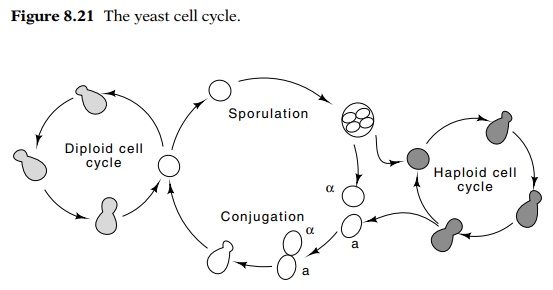Chapter: Genetics and Molecular Biology: Genetics
Elements of Yeast Genetics
Elements of Yeast Genetics
Yeast contain about 1.5 × 107 base pairs of DNA
per cell, about five times the amount per bacterium. Baker’s yeast,
Saccharomyces cerevisiae, contains 16 chromosomes. Consequently, most are
substantially smaller than the E. coli chromosome.
As already mentioned, yeast can be found as
haploids or diploids. This property greatly facilitates mutation isolation and
genetic analysis, and, combined with the small chromosome size, makes yeast a
good choice for experiments which require eukaryotic cells. A diploid yeast
cell can grow in culture much like a bacterium, although Saccharomyces divide
not in half like bacteria, but generate daughter buds which enlarge and finally
separate from the mother cell (Fig. 8.21). As mentioned earlier in this chapter,
in contrast to E. coli, but like some other bacteria, yeast can sporulate. This
occurs if they are starved of nitrogen in the presence of a nonfermentable
carbon source like acetate. In this 24 hour process, a single diploid yeast
cell undergoes meiosis and forms an ascus containing four spores. Upon
incubation in rich medium, the spores germinate and grow as haploid yeast
cells.

If one of the spores is isolated from an ascus
and grown up separate from other spores, the resulting culture is different from
the parental culture. The cells are haploid and they cannot sporulate. In fact,
an ascus contains two types of spores. These are designated as mating-types, a
and α. Both of these generate the haploid cultures and cannot sporulate.
If, however, a and α cultures are mixed, cells of opposite mating-type adhere and form mating pair aggregates. First the cytoplasms of these pairs fuse, and then the nuclei fuse to generate diploid cells which grow and remain diploids. The diploids then can sporulate and regenerate the haploids of mating-types a and α.
Recombination can be used for genetic mapping in yeast much as it is used in bacteria. Since no yeast viruses are known, genetic transfer must be accomplished either by the fusion of haploids as described above or by direct DNA transfer as described in a later on genetic engineering. Genetic recombination occurs during both meiosis and mitosis, but is much more frequent in meiosis.
Related Topics